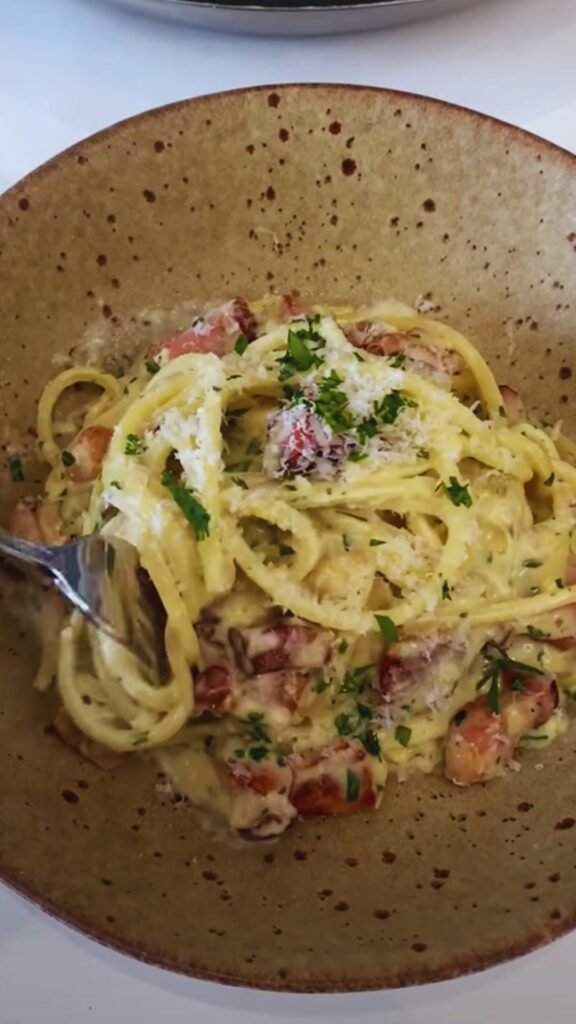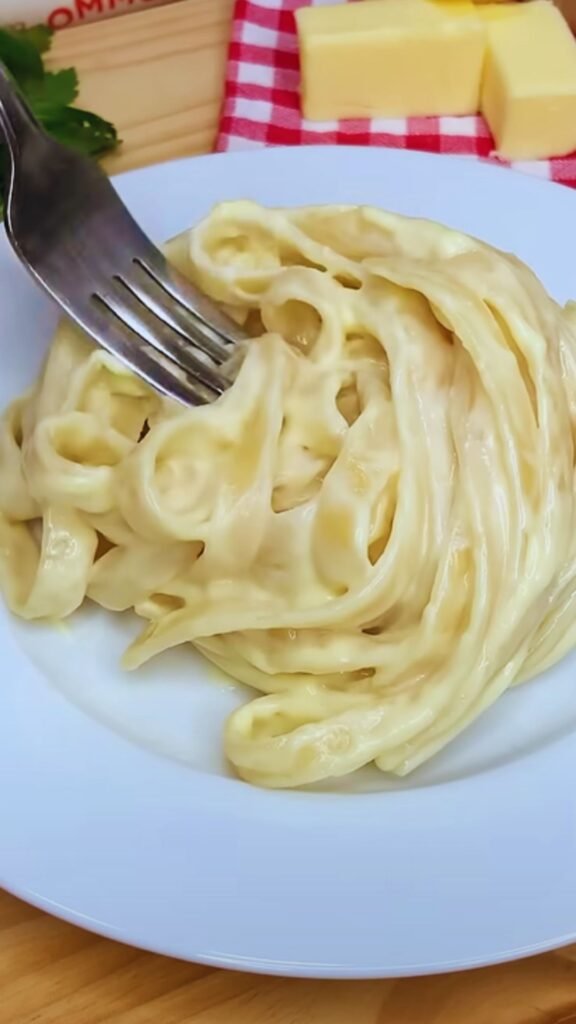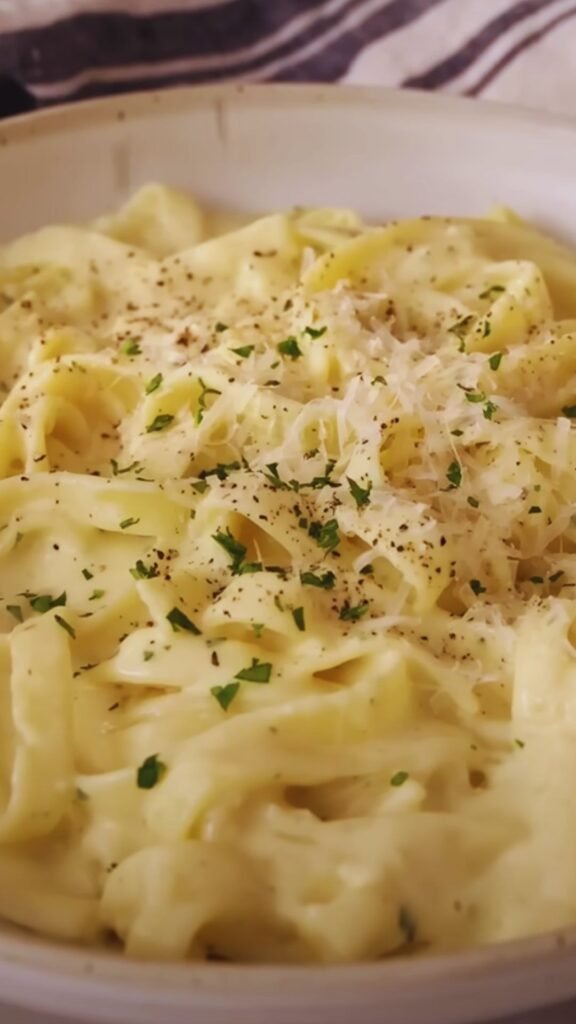There’s something magical about the moment when hot pasta meets egg, cheese, and pancetta to create that silky, glossy sauce that defines a perfect carbonara. As someone who has spent years perfecting this classic Italian dish, I’m excited to share my comprehensive guide to creating the ultimate creamy fettuccine carbonara that will transport you straight to the streets of Rome with each delicious bite.
The Heart and Soul of Carbonara
Carbonara is one of those deceptively simple dishes that relies on quality ingredients and proper technique rather than complexity. Traditional Roman carbonara contains just a few ingredients: pasta, eggs, cheese (Pecorino Romano and sometimes Parmigiano-Reggiano), cured pork (guanciale or pancetta), and black pepper. There’s no cream in authentic carbonara—the creaminess comes from the magical emulsion that forms when hot pasta meets egg and cheese.
The beauty of carbonara lies in its simplicity, but achieving that perfect silky texture without scrambling the eggs requires attention to detail. I’ve spent years refining my technique, making all the mistakes so you don’t have to. Whether you’re a carbonara newcomer or looking to perfect your recipe, this comprehensive guide will help you create a restaurant-quality dish in your own kitchen.
The History Behind the Dish
Before we dive into the recipe, let’s explore the fascinating origins of this beloved pasta. Carbonara’s history is somewhat contested, with several theories about its creation:
- Some believe carbonara originated with Italian charcoal workers (carbonai) who needed a hearty, easy-to-make meal while working in the Apennine mountains.
- Others suggest it emerged after World War II when American soldiers in Italy brought their rations of bacon and powdered eggs to local chefs.
- A third theory places its creation in the mid-20th century as a variation of pasta cacio e uova (cheese and eggs pasta), with the addition of American bacon.
What we do know is that carbonara as we recognize it today began appearing in Italian cookbooks around the 1950s. Unlike many Italian dishes with centuries of documented history, carbonara is relatively young, but it has quickly become one of the most iconic Italian pasta dishes worldwide.
Ingredient Deep Dive
The secret to exceptional carbonara starts with understanding each ingredient’s role in creating that perfect balance of flavors and textures.
The Pasta
While fettuccine makes for a luxurious carbonara with its wide surface area perfect for capturing the silky sauce, traditional Roman carbonara is typically made with spaghetti or rigatoni. The pasta should always be cooked al dente, with a firm bite that stands up to the rich sauce.
I prefer using fresh fettuccine when possible for its superior texture and ability to absorb the sauce, but high-quality dried pasta also works beautifully.
The Pork Element
The traditional choice for carbonara is guanciale—cured pork jowl with a distinct flavor profile that provides both fat and depth to the dish. Pancetta makes an excellent substitute and is more widely available outside Italy. In a pinch, good-quality thick-cut bacon will work, though it will impart a smokier flavor than traditional carbonara.
The Cheese
The cheese component is crucial to carbonara’s success. Authentic carbonara uses:
- Pecorino Romano: A sharp, salty sheep’s milk cheese that gives the dish its characteristic tang
- Parmigiano-Reggiano: Sometimes added in combination with Pecorino for a more complex flavor profile
Pre-grated cheese from containers should be avoided at all costs—these products often contain anti-caking agents that prevent proper melting and emulsification. Always grate your cheese fresh just before using.
The Eggs
Eggs create the creamy foundation of carbonara sauce without actual cream. Use the freshest eggs possible, preferably at room temperature to prevent temperature shock when they meet the hot pasta.
Traditional carbonara typically uses whole eggs plus additional yolks for extra richness. The ratio I’ve found works perfectly is one whole egg per serving plus one extra yolk for every two servings.
Black Pepper
Freshly cracked black pepper is non-negotiable for authentic carbonara. The “carbo” in carbonara is sometimes said to reference the black specks of pepper resembling coal dust, making this ingredient both practical and symbolic.

The Perfect Creamy Fettuccine Carbonara Recipe
Now that we understand our ingredients, let’s create the ultimate creamy fettuccine carbonara that balances tradition with accessibility.
Ingredients (Serves 4)
- 1 pound (450g) fettuccine (fresh preferred, but high-quality dried works well)
- 8 ounces (225g) guanciale or pancetta, cut into ¼-inch cubes
- 4 large eggs (at room temperature)
- 2 large egg yolks (at room temperature)
- 1 cup (100g) freshly grated Pecorino Romano
- ½ cup (50g) freshly grated Parmigiano-Reggiano
- 2 teaspoons freshly ground black pepper, plus more for serving
- ½ teaspoon salt (for pasta water)
- 2 tablespoons fresh Italian parsley, finely chopped (optional, for garnish)
Equipment Needed
| Equipment | Purpose | Notes |
|---|---|---|
| Large pot | Cooking pasta | Should hold at least 5 quarts of water |
| Large skillet | Cooking pancetta/guanciale | 12-inch skillet preferred |
| Large mixing bowl | Creating sauce mixture | Use heat-resistant glass or metal |
| Tongs | Transferring pasta | Helps preserve some pasta water |
| Wooden spoon | Stirring | Gentler than metal utensils |
| Cheese grater | Fresh grating cheese | Microplane or fine grater preferred |
| Kitchen thermometer (optional) | Monitoring temperatures | Helps prevent egg curdling |
Preparation Method
1. Prepare Your Ingredients
The key to smooth carbonara execution is having everything ready before you start cooking:
- Bring eggs to room temperature (leave out for 30 minutes or place in warm water for 5 minutes)
- Grate all cheese and combine in a bowl
- Cut guanciale or pancetta into even cubes
- Measure out black pepper
- Have a large, warmed serving bowl ready
2. Create the Base Sauce
- In a large bowl, whisk together the eggs, egg yolks, and three-quarters of the grated cheese mixture until well combined but not frothy.
- Add 1½ teaspoons of freshly ground black pepper to the egg mixture and whisk again. Set aside.
3. Cook the Pork
- Place a large, cold skillet on the stove and add the cubed guanciale or pancetta.
- Turn heat to medium-low and cook slowly, allowing the fat to render and the meat to become crisp around the edges but still tender inside (about 8-10 minutes).
- Once cooked to perfection, remove from heat but keep the rendered fat in the pan.
4. Cook the Pasta
- While the pork is cooking, bring a large pot of water to a rolling boil.
- Add ½ teaspoon of salt (less than you might normally use, as the pork and cheese are already salty).
- Add the fettuccine and cook until al dente according to package directions (usually 2-3 minutes for fresh, 9-11 minutes for dried).
- IMPORTANT: Reserve at least 1 cup of the starchy pasta water before draining.
5. The Critical Assembly
This step requires careful attention to temperature control to achieve that perfect creamy consistency without scrambling the eggs:
- Return the skillet with rendered fat to low heat.
- Using tongs, transfer the hot, drained pasta directly to the skillet, tossing to coat with the rendered fat.
- Add ¼ cup of the reserved pasta water to the skillet and toss the pasta again.
- Remove the skillet from heat completely and allow to cool for 30 seconds (this is crucial to prevent egg scrambling).
- Working quickly but carefully, pour the egg and cheese mixture over the pasta, using tongs to continuously toss and coat every strand.
- The residual heat from the pasta will gently cook the eggs, creating a creamy sauce. If the sauce seems too thick, add more reserved pasta water, a tablespoon at a time, until you reach your desired consistency.
6. Finishing Touches
- Transfer the finished carbonara to a warmed serving bowl.
- Sprinkle with the remaining grated cheese and black pepper.
- Garnish with chopped parsley if desired (this is a modern addition, not traditional).
- Serve immediately—carbonara waits for no one!

Troubleshooting Common Carbonara Challenges
Even experienced cooks can encounter issues when making carbonara. Here’s how to address the most common problems:
Scrambled Eggs Instead of Creamy Sauce
The most common carbonara disaster occurs when eggs scramble instead of forming a silky sauce.
Prevention:
- Ensure eggs are at room temperature before starting
- Remove pan from heat before adding egg mixture
- Continue tossing constantly during egg addition
- Add egg mixture gradually rather than all at once
Fix: If eggs begin to scramble, immediately remove from heat and add a splash of reserved pasta water while vigorously stirring to bring the sauce back together.
Too Dry or Too Watery
Achieving the perfect carbonara consistency can be tricky.
For Too Dry Sauce:
- Add reserved pasta water a tablespoon at a time until desired consistency is reached
- Never add milk or cream to thin sauce (this compromises authentic flavor)
For Too Watery Sauce:
- Continue tossing over very low heat until sauce thickens
- Add a small amount of additional grated cheese to absorb excess moisture
Uneven Sauce Distribution
Prevention:
- Use tongs to lift and toss pasta continuously during sauce addition
- Ensure egg mixture is well-combined before adding to pasta
- Consider using a wider pan to give more surface area for even coating
Nutritional Information
Understanding the nutritional profile of your carbonara can help you enjoy this indulgent dish as part of a balanced diet.
| Nutrient | Amount per Serving | % Daily Value* |
|---|---|---|
| Calories | 780 | 39% |
| Total Fat | 42g | 54% |
| – Saturated Fat | 18g | 90% |
| Cholesterol | 290mg | 97% |
| Sodium | 950mg | 41% |
| Total Carbohydrates | 65g | 24% |
| – Dietary Fiber | 2g | 7% |
| – Sugars | 2g | 4% |
| Protein | 36g | 72% |
| Calcium | 350mg | 27% |
| Iron | a3.5mg | 19% |
*Based on a 2,000 calorie diet
Variations and Adaptations
While I’m a purist at heart when it comes to carbonara, there are several thoughtful adaptations that maintain the spirit of the dish while accommodating different preferences or dietary needs.
Vegetarian Carbonara
Replace the pork with one of these flavorful alternatives:
- Sautéed mushrooms (particularly king oyster or shiitake for meaty texture)
- Roasted and diced eggplant seasoned with smoked paprika
- Crispy seasoned chickpeas
Increase the cheese slightly to compensate for the loss of savory depth from the pork.
Lighter Versions
For a lighter take on this rich dish:
- Use a higher ratio of egg whites to yolks
- Reduce the amount of cheese by about 30%
- Add 1-2 tablespoons of starchy pasta water to maintain creaminess
Adding Vegetables
While not traditional, these additions can create a more complete meal:
- Fresh spring peas (added in the last minute of pasta cooking)
- Blanched asparagus tips
- Wilted spinach or arugula folded in at the final toss

Serving Suggestions
Carbonara is a rich dish that pairs beautifully with simple, acidic side dishes that cut through the creaminess:
- Crisp arugula salad with lemon vinaigrette
- Roasted cherry tomatoes with balsamic glaze
- Steamed broccolini with garlic and lemon zest
- Crusty Italian bread for soaking up every last bit of sauce
Sparkling water with a splash of fresh lemon juice makes a refreshing beverage pairing that helps balance the richness of the dish.
Storing and Reheating (When Absolutely Necessary)
Carbonara is at its absolute best when freshly made and served immediately. The texture changes significantly once refrigerated, and reheating poses the risk of further cooking the eggs into a scrambled consistency.
If you must store leftovers:
- Refrigerate in an airtight container for no more than 24 hours.
- Reheat very gently in a skillet over low heat, adding a splash of water to revive the sauce.
- Add a sprinkle of freshly grated cheese after reheating to refresh the flavor.
Better yet, adjust the recipe quantities to make only what you’ll eat immediately—your taste buds will thank you!
Common Questions About Carbonara
Q: Can I use cream in authentic carbonara?
No, traditional Roman carbonara never contains cream. The creamy texture comes entirely from the emulsion of eggs, cheese, and starchy pasta water. Adding cream creates a different dish altogether—still delicious, but not traditional carbonara.
Q: Is carbonara safe to eat since the eggs aren’t fully cooked?
The residual heat from the pasta and pan does cook the eggs, but not to the point of hard scrambling. The internal temperature typically reaches around 145°F (63°C), which is sufficient to kill harmful bacteria in fresh eggs. If you’re concerned, use pasteurized eggs, especially when serving pregnant women, elderly people, or those with compromised immune systems.
Q: Can I make carbonara ahead of time for a dinner party?
Carbonara is notoriously time-sensitive and best enjoyed immediately after preparation. Instead of preparing ahead, I recommend having all ingredients measured and ready to go, so you can quickly prepare the dish just before serving. The actual cooking and assembly takes less than 15 minutes when properly prepared.
Q: What’s the difference between Alfredo and carbonara?
While both are creamy pasta dishes, they’re quite different:
- Carbonara uses eggs, hard cheese, cured pork, and black pepper
- Alfredo traditionally uses just butter and Parmigiano-Reggiano, though modern versions often include cream
- Carbonara has a more complex flavor profile with smoky notes from the pork and pepper
Q: How can I prevent the eggs from scrambling?
Temperature control is crucial. Remove the pan from heat before adding eggs, make sure eggs are at room temperature, and continuously toss the pasta while adding the egg mixture. Having some reserved pasta water ready to add can also help control the temperature and achieve the perfect consistency.
The Secret to Restaurant-Quality Carbonara at Home
After making thousands of plates of carbonara over the years, I’ve identified a few professional techniques that elevate home cooking to restaurant quality:
- Temperature management: Use a kitchen thermometer if you’re nervous about egg cooking—aim to keep everything between 140-150°F (60-65°C) during the critical sauce-forming stage.
- Quality of ingredients: With so few ingredients, each one matters tremendously. Use the best eggs, cheese, and pork you can afford.
- Mise en place: Having everything prepared and within arm’s reach before you start cooking makes the critical final steps go smoothly.
- Warmed plates: Restaurant carbonara stays creamy longer because chefs serve it on warmed plates. Place your serving dishes in a low oven (200°F/93°C) for a few minutes before plating.
- Speed of service: The difference between good and transcendent carbonara often comes down to how quickly it moves from pan to plate to fork.
By following these professional techniques and embracing the simple yet precise nature of carbonara, you’ll create a dish that honors its Roman heritage while delighting everyone at your table.
Whether you’re making carbonara for a romantic dinner for two or a family gathering, this dish has a way of creating moments of pure culinary joy. There’s something magical about transforming such simple ingredients into something so luxuriously delicious—a testament to the genius of Italian cuisine’s respect for quality ingredients and time-honored techniques.
So heat up that pasta water, crack those eggs, and prepare for a truly authentic taste of Rome right in your own kitchen. Buon appetito!



